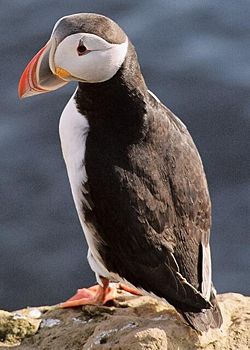|
The Puffin is actually the common name which describes any of the three known species of the auk (or alcids) speciesThe Puffin falls into the bird genus Fratercula, which is Latin for little brother. They can be found living close to the oceans, in coastal cliffs or offshore islands. They like to breed and nest in crevices among the rocks or in burrows in the ground. The Puffin get it's food primarily by diving. Their black and white plumage and brightly colored beak make them easy to spot. All three species of puffin have large bills. They swim under the water with a flying technique which is easily accomplished with their short wings. When The Puffin is flying directly over the ocean’s surface, their wings can beat up to 100 times per minute! The puffin can carry up to 30 fish in its mouth at one time, enabling them to have longer foraging times and fewer trips to feed their young. The Puffin forms long-term pair bonds, which is unusual compared to other animals. The female will lay a single egg, but both parents will incubate the egg and feed the chick small marine fish once it is born. Following fledging, chicks spend the first few years at sea and then return to breed after three to five years. The three species that are currently recognized are the Atlantic Puffin, Horned Puffin, and the Tufted Puffin.
The Atlantic Puffin is the only one that is found in the Atlantic Ocean. It is a pelagic seabird that can dive anywhere from 50 to 200 feet below the ocean’s surface, mostly for fish, but will also dine on crustaceans and squid. They spend their winters on the open ocean. The male Atlantic Puffin is general larger than the female, but they range in size from 28 to 34 centimeters in length and have a 50 to 60 centimeter wingspan. Breeding for this species takes place on the coasts of northern Europe, Iceland, and eastern North America. The bill is triangular and large. During the mating season, the bill is bright orange in color with a patch of blue bordered by yellow. These colors are seen before mating season and are shed soon after breeding. Tapping bills together is part of the courtship ritual. The male Atlantic Puffin is the one who builds the nest using grass, feathers and leaves, to safely hold the creamy white egg the female will lay. The Horned Puffin Similar in appearance to the Atlantic Puffin, this species of puffin is also an auk (Fratercula corniculata) and can be found off the costs of Alaska, Siberia, and British Columbia. It is also a seabird that spends a lot of time on the open sea and dives for fish. The bill is a bit different than the Atlantic Puffin, as it is yellow at the base and red at the tip. In addition, they have a black fleshy horn-like growth above their eyes, a white face and red feet. It nests in large colonies and the yellow plate is grown prior to breeding season and shed soon after the mating season ends. The Tufted Puffin Like the Atlantic Puffin and the Horned Puffin, this species is also a pelagic seabird, but is classified as Fratercula cirrhata. They are found throughout the Pacific Ocean and have been known to nest as far south as California. They weigh in at a slight three quarters of a kilogram and are about 30 centimeters in length. This puffin has a very large bill and is mostly black with a white facial patch. During breeding season, yellow tufts on the side of the head make their appearance. The male courts the female by strutting, sky pointing and using its bill to make special sounds. The female lays a single egg in a nest in a burrow lined with feathers and grasses. The egg is laid in June and the female shares the incubation responsibilities with her mate. Chicks hatch after about 45 days and leave the nest sometime after 55 days. Isolated islands are their choice for breeding. Horned Puffins feed on fish for the most part, but will also eat squid. This species, like the others, spends winter out on the open ocean. The plumage of the Horned Puffin changes from black and white to varying tones of blue
|

